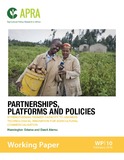| dc.contributor.author | Odame, Hannington | |
| dc.contributor.author | Alemu, Dawit | |
| dc.coverage.spatial | Ethiopia | en |
| dc.coverage.spatial | Ghana | en |
| dc.coverage.spatial | Zambia | en |
| dc.date.accessioned | 2018-03-15T09:26:12Z | |
| dc.date.available | 2018-03-15T09:26:12Z | |
| dc.date.issued | 2018-02-12 | |
| dc.identifier.citation | Odame Hannington and Alemu Dawit. (2018) ‘Partnerships, Platforms and Policies: Strengthening Farmer Capacity To Harness Technological Innovation For Agricultural Commercialisation’ APRA Working Paper 10, Future Agricultures Consortium | en |
| dc.identifier.isbn | 978-1-78118-431-8 | |
| dc.identifier.uri | https://opendocs.ids.ac.uk/opendocs/handle/20.500.12413/13585 | |
| dc.description.abstract | Innovation capacity presupposes capacity to harness science, technology and innovation (STI) for agricultural commercialisation. Agricultural commercialisation requires an enabling policy environment on STI issues such as impact of climate change, nutrition, improved
seed and inputs, emerging technologies, infrastructure,
research and extension, and financing. These issues
are consistent with the Science, Technology and
Innovation Strategy for Africa (STISA) 2024 (African
Union Commission undated).
This paper uses three STI revolution storylines (case
studies on rice, information and communications
technology (ICT) and cocoa) to highlight the enabling
factors that make STI a vehicle for agricultural
commercialisation. The case of rice commercialisation in
Ethiopia followed a more green revolution-type storyline,
with expected better yield-enhancing technologies, in
which research and development (R&D) – especially
seed sector development – has played an important
role. The ICT and agricultural commercialisation
storyline in Zambia followed application of an ICT and
mobile platform, which has been seen as an innovative
way to transform agribusiness in Africa. The cocoa
commercialisation storyline in Ghana shows impressive
growth as its supply has responded to policy reforms,
allowing a larger share of world cocoa prices to be
passed on to producers. The paper draws the following conclusions: Human capital and education of women and girls
is important – especially youth, who innovate and represent the future of agriculture in Africa.
STISA-2024 recognises the need to train young men and women in technology systems beyond
the traditional use of mobile phones in agriculture
to make it more resilient to climate change;
Producers’ organisations facilitate their members’
access to research, technologies, knowledge,
markets, financial services and policymaking
influence. The case of cocoa in Ghana shows that
cocoa farmers are increasingly being facilitated
to organise in groups as a prerequisite for
certification and for accessing technical, business
and credit services; Market mechanisms for farmers can provide
strong incentives for innovation. The case
of ICT and agricultural commercialisation in
Zambia is enabling market access for farmers
through a mobile platform. This has been seen
as an innovative way to transform agribusiness
because it can offer a wide range of solutions
for smallholder agricultural commercialisation in
Africa; Networks and linkages (e.g. partnerships,
innovation platforms) can provide a space for
information sharing, negotiation, planning and
action in an innovation system. This is exemplified
by a well-networked Ghana Cocoa Board
(COCOBOD), which implements government
programmes for farmers and other actors in the
cocoa value chain; An enabling environment for innovation should
involve representative producers’ organisations
in policymaking to take into account the needs
of farmers. Again, cocoa supply in Ghana has
shown impressive growth in response to proproducer
policy reforms.
Further, the paper identifies key areas for future
research: How is STI enabling commercialisation of
agricultural value chains to have positive
impacts on rural poverty, women’s and girls’
empowerment, and food and nutrition security? What are the specific contributions of the different
domains of innovation capacity in promoting
agricultural commercialisation? What is the role of STI in promoting non-farm rural
economies and rural–urban linkages? What attention should be given to youth in
agriculture? | en |
| dc.language.iso | en | en |
| dc.publisher | APRA, Future Agricultures Consortium | en |
| dc.relation.ispartofseries | APRA Working Papers;10 | |
| dc.rights.uri | http://creativecommons.org/licenses/by-nc-nd/3.0/ | en |
| dc.subject | Agriculture | en |
| dc.subject | Economic Development | en |
| dc.subject | Gender | en |
| dc.subject | Poverty | en |
| dc.subject | Rural Development | en |
| dc.title | Partnerships, Platforms and Policies: Strengthening Farmer Capacity to Harness Technological Innovation for Agricultural Commercialisation | en |
| dc.title.alternative | APRA Working Paper 10 | en |
| dc.type | Series paper (non-IDS) | en |
| dc.rights.holder | APRA, Future Agricultures Consortium | en |
| dc.identifier.team | Rural Futures | en |
| dcterms.dateAccepted | 2018-02-12 | |
| rioxxterms.funder | Department for International Development, UK Government | en |
| rioxxterms.identifier.project | APRA | en |
| rioxxterms.version | VoR | en |
| rioxxterms.funder.project | e1f6d3be-457a-4f13-8b1f-6748d1402d83 | en |


